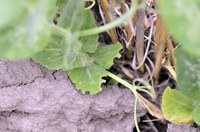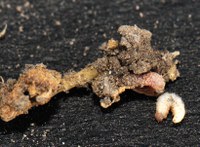Pea Leaf Weevil Detected in Western N.D.
(Click an image below to view a high-resolution image that can be downloaded)
Pea leaf weevil, an insect pest of dry pea, has been found in Golden Valley and Stark counties in southwestern North Dakota and in Mountrail County in north central North Dakota, reports Janet Knodel, North Dakota State University Extension Service entomologist.
In late summer of 2016, a pea producer in Golden Valley County submitted a sample of insects he found on his combine during pea harvest. The insects were positively identified as pea leaf weevil by Patrick Beauzay, NDSU Extension Service research specialist and state Integrated Pest Management (IPM) coordinator.
Leaf feeding notches caused by adult weevils, and larvae feeding on the root nodules were found in pea fields in these counties during field surveys this spring.
Pea leaf weevil is established in Virginia, Florida, the Pacific Northwest, Alberta, Saskatchewan and Montana. Pea leaf weevil larvae cause most of the economic damage to the pea plant by feeding on the nitrogen-fixing nodules. Nodule feeding injury reduces the level of nitrogen available for the crop and can decrease yield.
“We will be continuing our NDSU Extension IPM survey work throughout the summer to determine its range in the state,” says Beauzay. “We also would appreciate any new samples that producers, county Extension agents and crop consultants can provide.”
Samples should be submitted to NDSU Extension county agents, the NDSU Plant Diagnostic Lab, or directly to NDSU Extension Entomology for identification.
To determine if pea leaf weevils are present, look for these symptoms:
- In spring just after pea emergence, look for adult pea leaf weevil feeding notches on the lowest leaves of the plant, including the clam leaf. Notches are small semicircles in a symmetric pattern around the leaf margins. In plants where notches are present, look for larvae feeding in the root nodules.
- Look for feeding along field edges first.
- In summer, look for newly emerged adults beginning in late July. Adult weevils readily drop to the ground and may be difficult to find. Also, pea harvest may be underway at this time, and adults will migrate out of the field to feed on other legumes, such as alfalfa and sweet clover. These plants may harbor other weevils that look very similar to pea leaf weevil, so identification by an expert is required.
“We believe that pea leaf weevil has likely been in Golden Valley County for at least a few years,” says Beauzay. “In Stark and Mountrail counties, it appears to be just getting started.”
The main pest management tool is insecticide seed treatments. Adults rarely cause economic injury, but a foliar insecticide treatment may be needed when a threshold of 25 to 33 percent of plants have feeding notches on the clam leaves prior to the sixth node growth stage.
Knodel adds that it is too late for effective control measures this year. Pest management tools for pea leaf weevil will be discussed in more detail at Extension meetings this winter.
NDSU’s Crop and Pest Report features more information about the pea leaf weevil at http://bit.ly/PeaLeafWeevil.
NDSU Agriculture Communication - July 14, 2017
| Source: | Janet Knodel, 701-231-7581, janet.knodel@ndsu.edu |
|---|---|
| Source: | Patrick Beauzay, 701-231-7064, patrick.beauzay@ndsu.edu |
| Editor: | Kelli Armbruster, 701-231-6136, kelli.armbruster@ndsu.edu |



